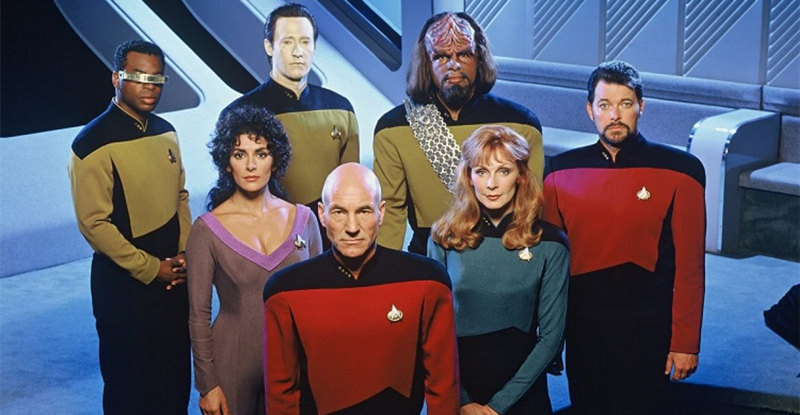My daughter isn’t a fan of black-and-white movies. Or dramas. Or old movies. Or ghost stories. Or films made in the old academy aspect ratio of 1.37:1, which translates to today’s widescreen TVs as a boxy-looking 1.33:1 presentation.
She was ready to leave the room when I popped in “The Ghost and Mrs. Muir,” but then my wife said, “I don’t remember anything about it, but I do remember liking it when I watched as a little girl.” So my daughter gave it a chance. And this popular 1947 drama, which fans voted the #1 Twentieth Century Fox film from the ‘40s that they wanted released on Blu-ray, held her attention until the end credits.
That’s saying something, and maybe explains why this quaint drama was a fan favorite. It holds your attention while you’re watching, and you remember it long after the credits have stopped rolling.
The year is 1900, and a pretty young widow named Lucy Muir (Gene Tierney) decides to lose the black dress and veil of mourning—it’s been a year since her husband’s untimely death—and leave the house of her mother-in-law (Isobel Elsom) and sister-in-law (Victoria Horne) with her daughter, in order to finally strike out on her own.
She needs a sea change. Tired of London, she decides to live in the seaside Gull Cottage with little Anna (Natalie Wood) and her maid, Martha (Edna Best), despite the warnings of the local realtor. None of the previous renters made it past one night in the house, and even after seeing an apparition that appears to be a ghost, the stubborn widow is determined to stay in a house that, for her, feels like home.
“I know you’re here,” she says defiantly to the ghost, who appears and holds the kind of conversation with her that one might encounter in a romantic drama—the kind of polite and slightly antagonistic banter that shows the distance a couple must travel in order to come together. Only “coming together” isn’t really an option in this romantic drama, as the main potential love interest is a spirit—of a figment of her imagination.
The ghost is the house’s former owner, a sea captain named Daniel Gregg (Rex Harrison), whom everyone says committed suicide because the gas was on and the windows closed—and one of his house servants testified that he always slept with the windows open. Of course it was a blasted accident! he blusters, and though his speech is meant to be salty, as befits a sailor (that’s SEAMAN—“sailor” is a landlubber term), Harrison and Tierney ‘s discourse has the kind of class and elegance that characterized Hollywood films from that era.
Director Joseph L. Mankiewicz knows how to flirt with sentiment without embracing it. He’s not afraid to let characters and their emotions drive the scenes, and though he didn’t receive an Academy Award nomination for “Ghost,” two years later he would win for an even more melodramatic drama: “A Letter to Three Wives.” In my book, “The Ghost and Mrs. Muir” is the superior film because it’s more restrained and the performances by Tierney and Harrison help to create a gentle tension that won’t yield until the film’s epilogue. And the only contrived moment in the film is the ending, which, if you think about it, couldn’t have been resolved any other way.
George Sanders plays the flesh-and-blood author who comes into the picture and threatens to disrupt the relationship that the Ghost has with Mrs. Muir. He’s smooth (He’s a poppinjay!) and his gallant gesture of giving up his appointment so that Mrs. Muir can meet with a publisher about a manuscript that, if sold, will help her to be able to afford to stay at Gull Cottage, sets him up as a white knight . . . or a black spot, depending on character point of view.
The adjectives I would use to describe the stars’ performances I would use as well to describe the film, they so dictate the tone and atmosphere. Words like “classy” and “elegant,” “subdued” or “restrained,” “delicate” and “quietly compelling.”
Visually, “The Ghost and Mrs. Muir” is stunning, even more so if you realize that it was filmed in California, not England, and that the wonderful cottage was completely built by the crew and it had no running water or electricity. It’s moviemaking at its sleight-of-hand finest.
“The Ghost and Mrs. Muir” is not rated, but it would probably rate PG today because of thematic content. But there’s nothing really scary, parents should know. Heck, that would have made it a totally different film.
Video:
Black levels are perfect in “The Ghost and Mrs. Muir,” creating nice contrasts and edge delineation even in shadowy scenes or night sequences. This black-and-white film looks as if it could have been made in the ‘60s, it’s so rich with detail and has only the slightest hint of grain to preserve the filmic quality. “Ghost” is presented in 1.33:1 aspect ratio, and I saw no problems with the AVC/MPEG-4 transfer (37 MBPS) to a 50GB disc. Well, except maybe a little ghosting. Sorry. That joke was low-hanging fruit. But compared to the DVD the video is much brighter and crisper.
Audio:
The audio is a surprising remix: an English DTS-HD MA 5.1 that sounds as contemporary as can be but doesn’t intrude upon the film’s charm or period atmosphere one bit. It’s a dialogue- and music-driven film, and both sound quite lovely, with a rich timbre and just enough bass to weight the low end. Additional audio options are an English DTS-HD MA 1.0 (I much prefer the fuller 5.1), a Spanish Dolby Digital 1.0, and a French DTS 5.1, with subtitles in English SDH, French, and Spanish.
Extras:
Surprisingly, two commentaries are included: one with film historian and Gene Tierney expert Jeanine Basinger and Mankiewicz biographer Kenneth Geist, and the other with visual effects specialist Greg Kimble and film historian Christopher Husted. Both are worth a listen.
The only other bonus feature is the theatrical trailer.
Bottom line:
Without the star power and without an intelligent script from two-time Oscar winner Philip Dunne, “The Ghost and Mrs. Muir” could have stumbled into melodrama or dramedy. It works as well as it does because of understatement, and it’s still a charming and captivating film more than 60 years later.


